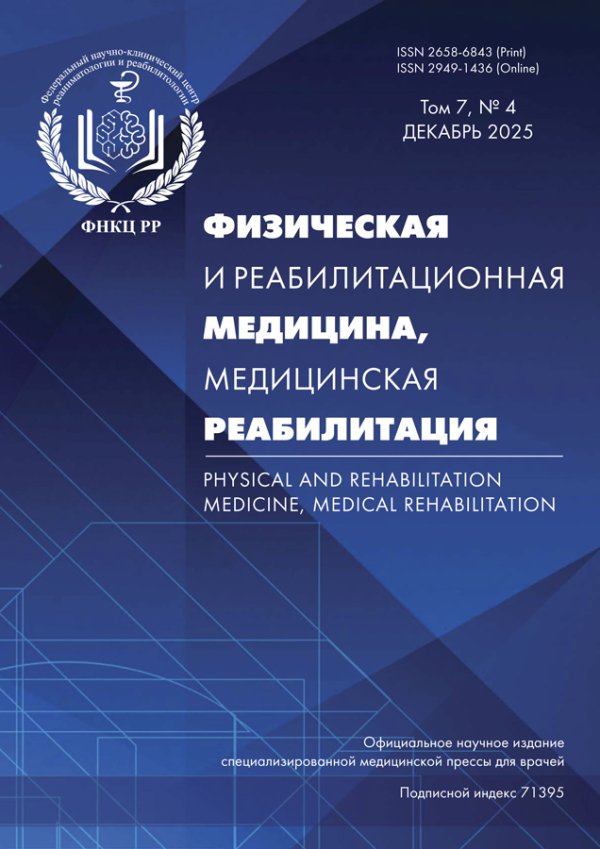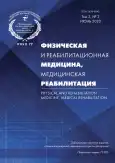Factors affecting exercise tolerance in cardiac patients at the third phase of rehabilitation
- Authors: Krivonogov V.A.1, Yastrebtseva I.P.1, Arkhipova S.L.1, Deryabkina L.Y.1
-
Affiliations:
- Federal State Budgetary Educational Institution of Higher Education “Ivanovo State Medical Academy” of the Ministry of Healthcare of the Russian Federation
- Issue: Vol 2, No 2 (2020)
- Pages: 118-125
- Section: ORIGINAL STUDY ARTICLE
- URL: https://journal-vniispk.ru/2658-6843/article/view/33779
- DOI: https://doi.org/10.36425/rehab33779
- ID: 33779
Cite item
Full Text
Abstract
Background. Cardiovascular diseases and their complications are the top cause of death and disability; the newly developed rehabilitation methods for these conditions have to be evaluated in terms of tolerability.
Objective. To examine the factors affecting better exercise tolerance in cardiac patients at the third phase of rehabilitation.
Methods. The study performed at IvGMA clinic involved 34 patients undergoing the 3rd phase of rehabilitation with a diagnosis of coronary heart disease: 5 (14%) — with acute Q myocardial infarction with ST segment elevation, 3 (9%) — without ST segment elevation, 3 (9%) — non-Q wave myocardial infarction, 23 (68%) — unstable angina pectoris. The age of patients was 49–76 years (average 59.47 ± 6.08 years), of which 23 were men and 11 women. Each patient underwent a complete clinical and functional examination to assess the anthropometric data, functional indicators of the respiratory and cardiovascular systems, mental functions, and posturography. The rehab course lasted 15 days and included exercise therapy, gym machine training according to an individually designed program, and dosed walking.
Results. Based on the results of exercise tolerance tests, we formed two case groups: patients of group 1 (n = 14) showed an improvement in the functional class of chronic heart failure according to 6-minute walking test; patients of group 2 (n = 20) showed only insignificant dynamics. Comparison of clinical and functional indicators between the 2 groups revealed that patients of group 1 had more pronounced anxiety and depressive symptoms, and a better preserved function of the respiratory system. A correlation analysis of the total sample of patients detected a correlation relationship between exercise tolerance and functions of the respiratory and cardiovascular systems, anthropometric data, and stabilogram indicators.
Conclusions. A better exercise tolerance in patients with heart problems was associated with better baseline functions of the respiratory and cardiovascular systems, a lower body mass index, and the optimal dose of statins taken. The exercise tolerance increased in parallel with improvement of stabilogram indicators, which suggests a positive effect of targeted individual training of the equilibrium function to improve the functional result of the cardiac rehabilitation process.
Full Text
##article.viewOnOriginalSite##About the authors
Vladislav A. Krivonogov
Federal State Budgetary Educational Institution of Higher Education “Ivanovo State Medical Academy” of the Ministry of Healthcare of the Russian Federation
Email: vladiv95@yandex.ru
ORCID iD: 0000-0003-2275-0104
ординатор первого года обучения по специальности «Неврология»
Russian Federation, IvanovoIrina P. Yastrebtseva
Federal State Budgetary Educational Institution of Higher Education “Ivanovo State Medical Academy” of the Ministry of Healthcare of the Russian Federation
Author for correspondence.
Email: ip.2007@mail.ru
д.м.н., профессор кафедры неврологии и нейрохирургии
Russian Federation, IvanovoSvetlana L. Arkhipova
Federal State Budgetary Educational Institution of Higher Education “Ivanovo State Medical Academy” of the Ministry of Healthcare of the Russian Federation
Email: arkhipova_sl@mail.ru
к.м.н., доцент кафедры госпитальной терапии
Russian Federation, IvanovoLidiya Yu. Deryabkina
Federal State Budgetary Educational Institution of Higher Education “Ivanovo State Medical Academy” of the Ministry of Healthcare of the Russian Federation
Email: deryabkina-72@mail.ru
к.м.н.; врач лечебной физкультуры клиники
Russian Federation, IvanovoReferences
- Иванов Д.О., Орел В.И., Александрович Ю.С., и др. Заболевания сердечно сосудистой системы как причина смертности в Российской Федерации: пути решения проблемы // Медицина и организация здравоохранения. — 2019. — Т. 4. — № 2. — С. 4–12. [Ivanov DO, Orel VI, Aleksandrovich YS. Diseases of the cardiovascular system as the leading cause of death in Russian Federation: ways of problem solution. Medicina i organizacija zdravoohranenija. 2019;4(2):4–12. (In Russ).]
- Timmis A., Townsend N., Gale C.P. European society of cardiology: cardiovascular disease statistics 2019 (executive summary) // European Heart Journal. Quality of Care & Clinical Outcomes. 2020; 6:7–9. Doi: https://doi.org/10.1093/ehjqcco/qcz065
- Мамедов М.Н. Динамика факторов риска и сердечно-сосудистых заболеваний: аналитический обзор международных и российских данных за 2017 год // Международный журнал сердца и сосудистых заболеваний. — 2018. — Т. 6. — № 19. — С. 32–36. [Mamedov MN. Dinamika faktorov riska i serdechnososudistyh zabolevanij: analiticheskij obzor mezhdunarodnyh i rossijskih dannyh za 2017 god. Mezhdunarodnyj zhurnal serdca i sosudistyh zabolevanij. 2018;6(19):32–36. (In Russ).]
- Аронов Д.М. Основы кардиореабилитации // Кардиология: Новости. Мнения. Обучение. — 2016. — № 3. — С. 104–110. [Aronov DM. Osnovy kardioreabilitacii. Kardiologija: Novosti. Mnenija. Obuchenie. 2016;(3): 104–110. (In Russ).]
- Довгалюк Ю.В., Мишина И.Е., Чистякова Ю.В. Динамика толерантности к физической нагрузке в оценке эффективности программ реабилитации больных, перенесших острый коронарный синдром, на амбулаторном этапе // Вестник восстановительной медицины. — 2019. — № 3. — С. 11–14. [Dovgalyuk YV, Mishina IE, Chistyakova YV. The dynamics of tolerance to physical activity in evaluating the effectiveness of programs of rehabilitation of patients with acute coronary syndrome at the outdoor stage. Vestnik vosstanovitel’noj mediciny. 2019;(3):11–14. (In Russ).]
- Архипова С.Л., Чистякова Ю.В., Мишина И.Е., и др. Значение оценки функции внешнего дыхания в определении эффективности амбулаторного этапа кардиореабилитции // Вестник Ивановской медицинской академии. — 2018. — Т. 23. — № 4. — С.13–17. [Arkhipova SL, Chistyakova YuV, Mishina IE, et al. External respiration function evaluation and its significance in the determination of cardiorehabilitative ambulatory stage effectiveness. Bulletin of the Ivanovo Medical Academy. 2018;23(4):13–17. (In Russ).]
- McMahon S.R., Ades P.A., Thompson P.D. The role of cardiac rehabilitation in patients with heart disease // Trends in Cardiovascular Medicine. 2017; 27: 420–425. Doi: https://doi.org/10.1016/j.tcm.2017.02.005.
- Давыдов П.В. Стабилометрия в вертикализации больных с острым инфарктом миокарда на стационарном этапе восстановительного лечения: Дис. … канд. мед. наук. — М., 2006. — 124 с. [Davydov PV. Stabilometriia v vertikalizatsii bol’nykh s ostrym infarktom miokarda na statsionarnom etape vosstanovitel’nogo lecheniia. [dissertation] Moscow; 2006. 124 р. (In Russ).] Доступно по: https://search.rsl.ru/ru/record/01004299657. Ссылка активна на 12.01.2020.
- Мещерякова Н.Н. Принципы легочной реабилитации больных хронической обструктивной болезнью легких // Практическая пульмонология. — 2013. — № 2. — С. 27–31. [Meshherjakova NN. Principy legochnoj reabilitacii bol’nyh hronicheskoj obstruktivnoj bolezn’ju legkih. Prakticheskaja pul’monologija. 2013;(2):27–31. (In Russ).]
- Черных Ю.Н., Болотских В.И., Цветикова Л.Н., и др. Динамика бронходилятационных показателей и показателей толерантности к физической нагрузке у больных хронической обструктивной болезнью легких с сопутствующей ишемической болезнью сердца // Вестник новых медицинских технологий. Электронное издание. — 2013. — № 1. — С. 236. [Chernyh YuN, Bolotskih VI, Tsvetikova LN, et al. Dynamics bronhodilyatatsionnyh scores andexercise tolerance in obstructive pulmonary disease patientes with cconcomitant coronari artery dyase. Journal of new medical technologies. 2013;(1):236. (In Russ).]
- Оленская Т.Л., Николаева А.Г., Соболева Л.В. Реабилитация в пульмонологии: учебно-методическое пособие. — Витебск: ВГМУ, 2016. — 142 с. [Olenskaia TL, Nikolaeva AG, Soboleva LV. Reabilitatsiia v pul’monologii: uchebno-metodicheskoe posobie. Vitebsk: VGMU; 2016. 142 р. (In Russ).]
- Crisafulli E., Aiello M.A., P.Tzani et al. А high degree of dyspnea is associated with poor maximum exercise capacity in subjects with copd with the same severity of air-flow obstruction // Respiratory Care. — 2019. — № 64. — PP. 390–397. Doi: https://doi.org/10.4187/respcare.06336.
- Овчинников А.Г., Потехина А.В., Ибрагимова Н.М., и др. Механизмы плохой переносимости физической нагрузки у больных сердечной недостаточностью с сохраненной фракцией выброса. Часть II: роль правых камер сердца, сосудов и скелетной мускулатуры // Кардиология. — 2019. — № 8. — С. 4−14. [Ovchinnikov AG, Potekhina AV, Ibragimova NM, i dr. Mekhanizmy plokhoi perenosimosti fizicheskoi nagruzki u bol’nykh serdechnoi nedostatochnost’iu s sokhranennoi fraktsiei vybrosa. Chast’ II: rol’ pravykh kamer serdtsa, sosudov i skeletnoi muskulatury. Kardiologiia. 2019;(8):4–14. (In Russ).]
- Мерзликина Н.Л. Динамика основных показателей функции внешнего дыхания и сердечно-сосудистой системы на фоне снижения массы тела у больных с экзогенно-конституциональным ожирением: Автореф. дис. … канд. мед. наук. — М., 2010. — 25 с. [Merzlikina N.L. Dinamika osnovnykh pokazateley funktsii vneshnego dykhaniya i serdechno-sosudistoy sistemy na fone snizheniya massy tela u bol’nykh s ekzogenno-konstitutsional’nym ozhireniyem. [dissertation abstract] Moscow; 2010. 25 р. (In Russ).] Доступно по: https://search.rsl.ru/ru/record/01003490569. Ссылка активна на 12.01.2020.
- Alpert MA., Omran J., Bostick B.P. Effects of obesity on cardiovascular hemodynamics, cardiac morphology, and ventricular function // Current Therapeutic Research. 2016; 5:424–434. DOI: https://doi.org/10.1007/s13679-016-0235-6.
Supplementary files








